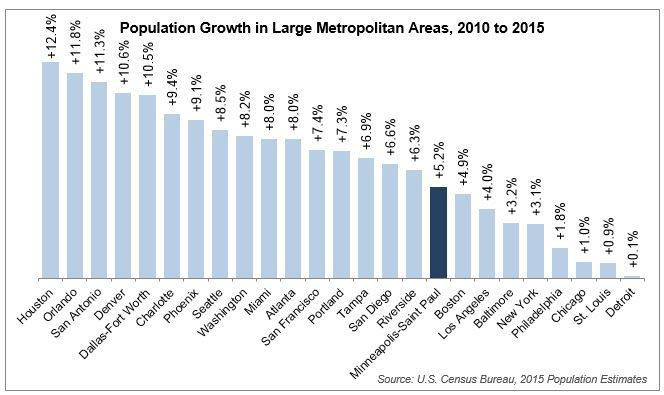Twin Cities Metro Region Hits Record-High Population, Surpasses 3 Million Residents
Contact: Kate Brickman
Metropolitan Council Communications Director
651-602-1518 office
Kate.brickman@metc.state.mn.us
Saint Paul – March 24, 2016 – The Twin Cities Metropolitan
Region has reached its highest population in history, surpassing more than 3
million residents.
The U.S. Census Bureau released its population estimates for
2015 on Thursday, showing a population increase of more than 162,000 people for
the seven-county metro region since 2010. The seven-county area includes Anoka,
Carver, Dakota, Hennepin, Ramsey, Scott, and Washington Counties. The estimated
population count for the region as of July 1, 2015 is 3,012,117, a 5.7%
increase over five years.
“Hitting this historic mark shows that our region is thriving –
people want to live here, to work here, to raise their families
here,” said Metropolitan Council Chair Adam Duininck. “As we at the Met Council focus on how to foster efficient
growth across the region, this milestone assures us that these efforts are
paying off.”
Further analysis of the U.S. Census Bureau data by Met
Council shows the region accounted for 88% of the state’s net population growth
since 2010. The Twin Cities region collectively has 55% of the state’s
population. (See Chart 1)
The data also shows that the metropolitan region is growing
at a faster rate than the national increase (4.1%), as well as more established
metro regions like Boston, New York and Chicago. This growth rate focuses on a
broader 16-county metropolitan region, which is the statistical area the U.S.
Census Bureau uses. When looking at that broader statistical metro region, we experienced
the 17th-fastest growth rate among the country’s 25 most populous
metro areas. (See Chart 2) Among major metro areas in
the Midwest, the Twin Cities’ growth rate is the third-highest. (See Chart 3)
“The Met Council works to ensure our region can compete against
our peer regions, places like Denver, Dallas, and Seattle. We compete for
businesses and a talented workforce. While we rate well compared to other large
regions in the Midwest, there is room for improvement,” said Duininck.
“When looking at the regions growing faster than ours, one of the
common threads is a strong regional transit system. As we continue to grow as a
region, we are not keeping up when it comes to investments in our infrastructure,”
continued Duininck. “With more people choosing to live here, we need to
provide transportation options. More transit will keep moving people and goods
throughout our region efficiently, without adding to traffic congestion. A
growing region means we need a growing transit system.”
About two-thirds of the Twin Cities region’s growth came
from “natural increase” (more people are being born than are dying). The
remainder of the increase came from international migration (more people are
moving into the region from outside the U.S. than are moving out).
The Census Bureau’s county population estimates
serve as a consistency check for the official Metropolitan Council population
estimates for cities and townships in the Twin Cities region. These estimates
will be prepared and delivered to cities in May 2016 for their review, then
certified and released in July.
Chart 1

Chart 2

* In
addition to the seven counties in the Twin Cities region, the U.S. Census
Bureau includes 9 additional counties for its metropolitan statistical area.
Those statistics include Chisago, Isanti, Le Sueur, Mille Lacs, Sherburne,
Sibley, and Wright Counties in Minnesota and Pierce and St. Croix Counties in
Wisconsin. According to the Census Bureau’s 2015 population estimates, the Twin
Cities region constitutes 85% of the 16-county metropolitan area’s population
and 93% of the metropolitan area’s net population growth since 2010.
Chart 3

#
|




